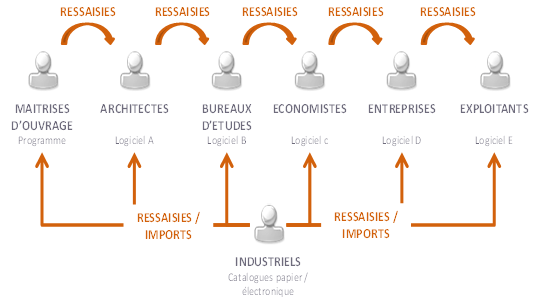
How are we preparing for the digital future in the construction sector?
Reading time: 5 minutes
Since the 70's, computer science has started to be implemented in the building sector, we managed to collect data from different databases: docs, excels, paper and softwares of all kinds. Different people are in charge of the structuring of this database, that is to say the digitization of the building: plans, electrical diagrams, standards, etc... Therefore, each person is the master of his data and the tools used are not the same for each operator in the company...
Most of the time this is not interoperable because each data source is structured differently. No one other than the data modeler himself usually understands the model, so a company's own created data can neither be read nor used through its own services.
If the value of the company is its data, then it is lost with the departure of each operator.
In this article:
What about the transmission between the different actors during operation and maintenance, which is 80% of the building's life cycle?
Even if the problem of data transmission was foreseeable, it was not taken into account enough, and we find ourselves with a shortage of qualified people with a double competence: an awareness of the digital transformation of the building (transmission of DATA) and skills in construction.
The implementation of the BIM obligation has had the merit of highlighting the difficulty of the digital continuity of the building. If for some the BIM remains a simple 3D visualization, its real value lies in the data that can be attached to it to achieve a dynamic, living representation of the physical and functional characteristics of a building.
In this way, beyond the 3D views (width, depth, height), we will also be able to integrate other dimensions such as time (4D), financial (5D), environmental (6D), patrimonial (7D) data...
It is above all a technical database, made up of objects defined by their characteristics and their relationships with each other. The whole results in a structured set of information on buildings and structures (https://buildingsmartfrance-mediaconstruct.fr/definition-notions-bim/).
As in any language, to understand each other you need a common dictionary to refer to in order to speak the same language. This is the role of the IFC interoperability standards.
It took a long time and we are still far from a true understanding of a universal language and from questioning the way we work. The implementation of interoperable office automation tools and software represents an organizational effort and a significant budget.
Furthermore, when it comes to IT investments, it is necessary to plan for tools that evolve over time. We had a period of closed, non-agile tools that remained impervious to any interoperability.
Gartner forecasts a 5.1% increase in IT spending, or $4500 billion by 2022, with a real desire to invest in agile and scalable SaaS software.
(https://itchannel.info/articles/193255/vers-une-nouvelle-hausse-des-depenses-informatiques-en-2022.html)
Usually during the delivery of the DOE, a lot of important information is lost between each step because the actors are generally not the same and do not use the same tools or work with incompatible data formats (CAD, DAO, spreadsheet, word processing). The loss of profit on transmission errors remains a significant budget "It is estimated that the annual cost of inconsistencies in the building industry in France is well over 10 billion euros" (https://fr.wikipedia.org/wiki/Building_information_modeling
In fact, it is estimated that the information on a building is entered an average of seven times.
Usually when delivering the DOE (Dossier des Ouvrages Exécutés), a lot of important information is lost between each step because the actors are generally not the same and do not use the same tools or work with incompatible data formats (CAD, DAO, spreadsheet, word processing).
The loss of earnings on transmission errors remains a significant budget " It is estimated that the annual cost of inconsistencies in the building industry in France is well over 10 billion euros (https://fr.wikipedia.org/wiki/Building_information_modeling)
In fact, it is estimated that the information on a building is entered an average of seven times.

Both data transfer and knowledge transfer should be emphasised.
With the acceleration of digital technology, new tools, new technologies and new knowledge, a new approach to the world of construction is emerging, breaking down the silos of the building industry.
You have to be willing to learn and relearn. The number of retraining and training is increasing, we like to learn and unlearn, it is a new impulse that is growing in recent years.
We don't do the job we learned in school in the same way anymore. Some have a more mature digital culture than others and it is in this interest that we have to mix seniors and juniors.
As we continue to diversify and learn, we are both teacher and student as Ralph Montague would say
Interoperability is like social interactions: there are those who always want to acculturate us, teach us and accompany us to make a continuity of knowledge, a real transmission, it feeds us.
The profession of tomorrow is not learned at school but by continuing to want to do better and to work together. It is very sad not to be open to others, we lose all the magic of teaching and receiving our social part, finally our part of humanity.
Vision by Algo'tech is a No-Code platform for creating professional applications, all in one.
Create your mobile & desktop user interfaces + the database that feeds them + the processes to guide the user through the application + the API connections.
The platform also offers you to host your creations in a centralized space to manage multiple applications, users and their rights.


